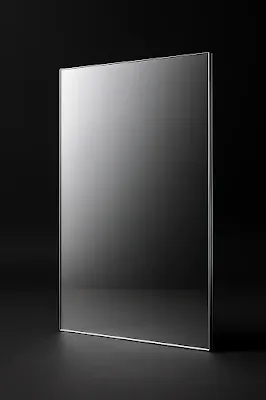Imagine standing in front of a mirror so flawless, it reflects every single photon of light. No absorption. No transmission. Just pure, unbroken reflection. Welcome to the fascinating world of the perfectly reflective mirror. This idea is still theoretical, but it is driving scientific progress. It is transforming technologies in optics, medicine, and computing. Its impact reaches far beyond these fields.
What Makes a Mirror "Perfect"?
Reflection, in simple terms, is light bouncing off a surface. According to the law of reflection, the angle at which light hits a surface is equal to the angle at which it bounces off. Most mirrors follow this rule, but their efficiency—how much light they actually reflect—varies.
Everyday mirrors, like the one in your bathroom, reflect about 85% to 95% of visible light. The rest is either absorbed or passes through. These standard mirrors typically use a thin layer of aluminum or silver on a glass substrate. They're good—but not perfect.
To approach perfection, a mirror must reflect close to 100% of incident light. That means no light gets lost to absorption or scattering. Achieving this requires precision engineering at the atomic level, and that's where dielectric mirrors come in.
The Science Behind Dielectric Mirrors
Dielectric mirrors, also known as Bragg mirrors, aren't made from metal. Instead, they're built from multiple layers of non-metallic materials with differing refractive indices. Think of them like a layered cake—each layer designed to reflect light in just the right way.
When light hits these layers, the waves reflected from each one line up perfectly through a process called constructive interference. This boosts overall reflectivity, often exceeding 99.9% for specific wavelengths of light.
In 1998, MIT scientists took it a step further. They created a dielectric mirror that reflected light from any angle and polarization—something traditional versions struggled with. This breakthrough, dubbed the "perfect mirror," was a major leap in optical science.
Why This Matters: Real-World Applications
You might not think about mirrors much, but high-reflectivity mirrors are essential to modern life. In laser systems, for instance, they bounce light between mirrors to build up the laser beam. The better the mirror, the more powerful and efficient the laser.
Astronomy relies heavily on these mirrors too. Telescopes need to capture faint light from galaxies billions of light-years away. A more reflective mirror means clearer images and better data.
In medicine, precise laser mirrors make surgeries safer and more effective. By minimizing energy loss, they allow doctors to target tissues with incredible accuracy. And in the fast-growing field of quantum computing, optical mirrors help create the ultra-sensitive environments needed for quantum bits, or qubits.
The Limits of Perfection
Even the best mirrors today aren't truly perfect. Most dielectric mirrors only reflect certain wavelengths and are sensitive to the angle of incoming light. That means they're amazing in specific settings but not one-size-fits-all.
Also, the manufacturing process isn't flawless. Tiny imperfections in materials or alignment can reduce reflectivity. So while we're close to perfection, there's still a gap between theory and reality.
But that doesn't mean scientists are giving up. On the contrary, the chase for perfection drives innovation. New materials, like metamaterials and nano-structured coatings, are being researched to overcome current limits. The dream is a mirror that works perfectly across all wavelengths, from visible light to X-rays.
Future Tech: Where Perfect Mirrors Could Take Us
Think beyond mirrors hanging on a wall. Near-perfect reflectors could enable major advances in fiber-optic communication, making internet speeds faster and more reliable. In space exploration, lighter, more efficient mirrors could help build next-generation satellites and telescopes.
Perfect mirrors could also play a key role in solar energy. By maximizing how much sunlight gets bounced and concentrated onto a solar cell, they could significantly increase energy output.
And then there's the fun stuff—like invisibility cloaks. Perfectly reflective materials could manipulate light in ways that bend it around objects, making them appear invisible. It's sci-fi, but not as far off as you might think.
Final Thoughts
The idea of a perfectly reflective mirror may sound like science fiction, but it’s becoming science fact. Though we're not quite there yet, each step toward perfection brings new breakthroughs and applications.
From powering tomorrow's lasers to unlocking the secrets of the universe, these mirrors are more than just shiny surfaces. They're windows into the future of technology.
Disclaimer: This article reflects scientific knowledge and developments up to May 2025.
About the Author
Dinesh Kumar is a physics graduate from St. Joseph’s College, Tiruchirappalli, and a qualified IIT JAM candidate. He is currently researching dark matter and time dilation, with a strong passion for exploring the mysteries of space, time, and the universe.
Dinesh runs the blog Physics and Beyond, where he shares over 100 engaging articles that break down complex science into fun, accessible language. His mission is to make science enjoyable and easy to understand for everyone.
When he's not writing or researching, you'll find him reading about the cosmos or testing new science ideas. Dinesh believes in truth, clarity, and curiosity—and brings those values to every post.
Contact: dineshkumark94874@gmail.com

